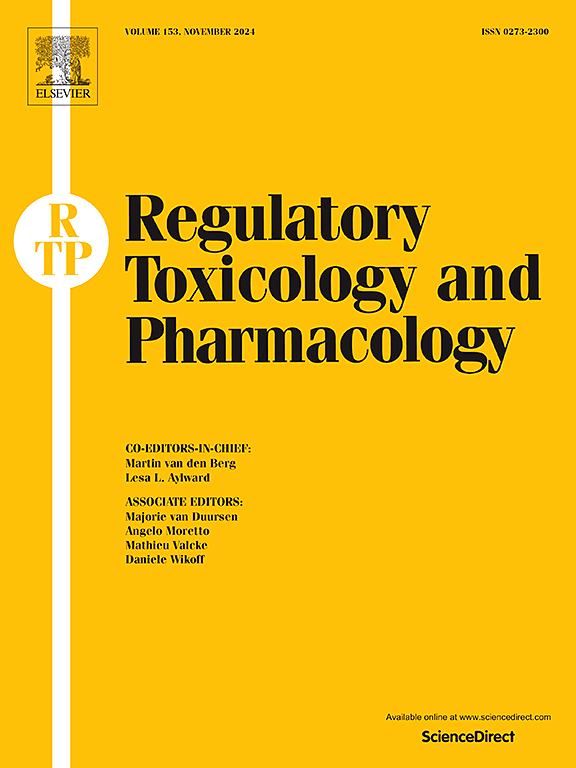从再生纸食品接触材料迁移的污染物的体外危害表征
IF 3
4区 医学
Q1 MEDICINE, LEGAL
引用次数: 0
摘要
纸质食品接触材料(fcm)的安全性对公众健康至关重要,需要进行精确的毒性评估。本研究考察了样品制备方法(迁移和提取)、肝脏代谢酶、内源性配体和各种细胞系对纸质fcm体外毒性的影响。毒理学终点包括诱变性、遗传毒性、潜在的雌激素性、雄激素性、芳烃受体活性以及对肝细胞和结肠肠上皮屏障的细胞毒性,使用HepG2和Caco-2细胞系。采用两种制备方法:根据2011年10月欧盟委员会法规迁移和穷尽索氏提取。与迁移相比,提取显示出不同的毒理学特征,在更多的端点显示出毒性,可能是由于不同的样品条件影响化学特性和浓度。肝脏代谢酶的添加改变了雌激素和雄激素活性,而内源性配体影响雌激素和雄激素活性试验的效力。将提取和迁移方法与生理学相关模型相结合,可以增强对纸质fcm危害的评估。这包括将模拟靶组织(如肝脏和肠上皮)的细胞系与雌激素受体α和雄激素活性测试中的代谢酶和内源性配体结合起来,为全面评估食品接触材料中的危害提供策略。本文章由计算机程序翻译,如有差异,请以英文原文为准。

In vitro hazard characterization of contaminants migrating from recycled paper food contact materials
The safety of paper food contact materials (FCMs) is critical for public health, necessitating precise toxicity assessments. This study investigates the impact of sample preparation methods (migration and extraction), liver metabolic enzymes, endogenous ligands, and various cell lines on the in vitro toxicity of paper FCMs. Toxicological endpoints include mutagenicity, genotoxicity, potential estrogenicity, androgenicity, aryl hydrocarbon receptor activity, and cytotoxicity to hepatocytes and the colon intestinal epithelial barrier, using HepG2 and Caco-2 cell lines. Two preparation methods were employed: migration per Commission Regulation (EU) October 2011 and exhaustive Soxhlet extraction. Extraction revealed distinct toxicological profiles compared to migration, exhibiting toxicity in more endpoints, potentially due to different sample conditions affecting chemical identity and concentration. The addition of liver metabolic enzymes altered estrogenic and androgenic activity, while endogenous ligands influenced potency in estrogenicity and androgenicity tests. Integrating extraction and migration methods with physiologically relevant models enhances the evaluation of hazards from paper FCMs. This involves incorporating cell lines that mimic target tissues, such as liver and intestinal epithelium, alongside metabolic enzymes and endogenous ligands in estrogen receptor alpha and androgen activity testing, providing a strategy for the comprehensive assessment of hazards in food contact materials.
求助全文
通过发布文献求助,成功后即可免费获取论文全文。
去求助
来源期刊
CiteScore
6.70
自引率
8.80%
发文量
147
审稿时长
58 days
期刊介绍:
Regulatory Toxicology and Pharmacology publishes peer reviewed articles that involve the generation, evaluation, and interpretation of experimental animal and human data that are of direct importance and relevance for regulatory authorities with respect to toxicological and pharmacological regulations in society. All peer-reviewed articles that are published should be devoted to improve the protection of human health and environment. Reviews and discussions are welcomed that address legal and/or regulatory decisions with respect to risk assessment and management of toxicological and pharmacological compounds on a scientific basis. It addresses an international readership of scientists, risk assessors and managers, and other professionals active in the field of human and environmental health.
Types of peer-reviewed articles published:
-Original research articles of relevance for regulatory aspects covering aspects including, but not limited to:
1.Factors influencing human sensitivity
2.Exposure science related to risk assessment
3.Alternative toxicological test methods
4.Frameworks for evaluation and integration of data in regulatory evaluations
5.Harmonization across regulatory agencies
6.Read-across methods and evaluations
-Contemporary Reviews on policy related Research issues
-Letters to the Editor
-Guest Editorials (by Invitation)

 求助内容:
求助内容: 应助结果提醒方式:
应助结果提醒方式:


